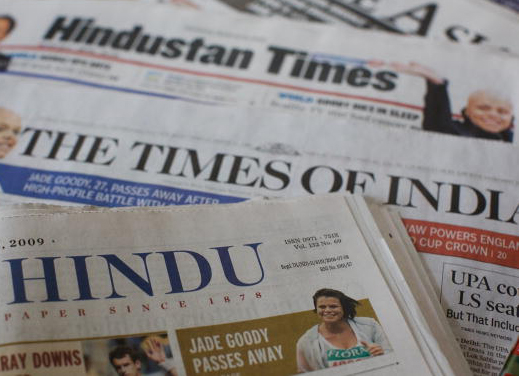
India Inc snaps up $29.3 billion overseas assets in 2013-14
Outward foreign direct investment from India, has seen some signs of recovery in the current fiscal with the total deal value touching $29.3 billion so far, says a report. "The period between FY07 and FY11 has been buoyant at times for outward FDI investments, but there has been a slowdown since then. Investments declined in FY12 and FY13, but there has been a recovery in FY14 so far," Care Ratings said in a report. Total FDI investments made by domestic companies between April-January of FY14 stood at $29.34 billion, the report said. The declining trend in outward FDI started from FY11 when it stood at $19.25 billion to $11.18 billion in FY12, and to $7.13 billion in FY13. The rating agency said after moderate FDI investment between FY03 and FY04, investments started gradually increasing because of the relaxations in overseas investment policy in 2004.
(Source: Times of India)
FIIs invest Rs 5,000 crore in Indian equities in two weeks
Foreign investors poured in over Rs 5,000 crore in the Indian stock market in a fortnight, mainly on hopes of a strong mandate for the government to be elected in polls starting next month. Foreign institutional investors (FIIs) were gross buyers of shares worth Rs 42,035 crore and sellers of stocks to the tune of Rs 36,967 crore till March 14, resulting in a net inflow of Rs 5,068 crore ($828 million), according to data with the Securities and Exchange Board of India. FIIs also infused Rs 14,140 crore ($2.3 billion) in the debt market during the period. According to market analysts, a sharp drop in the current account deficit and easing inflation, which bolstered expectations that the economy will see a turnaround soon, as well as hopes for a strong mandate for the next government prompted overseas investors to pump in money in equities. FIIs, the major drivers of the Indian stock market, have helped push the benchmark BSE Sensex almost 690 points, or 3.26 per cent so far this month. Overseas investors have purchased a net Rs 7,186 crore of stocks so far in 2014. They invested a net Rs 1,404 crore in equities in February and Rs 714 crore in stocks in January. As of March 14, there were 1,719 registered FIIs in the country and 6,318 sub-accounts.
(Source: Times of India)
Panasonic to make India regional hub
The Osaka-based, $76-billion company has decided to make India its regional hub to service the subcontinent, Middle East and Africa. It is also moving one of its top honchos-Yoshihiko Yamada, to be headquartered in New Delhi to directly take care of these regions as also create synergies between India, Asean and China. Besides, India will now be developed as the hub for product development, R&D, business solutions and would also serve as the global sourcing base for mobile phones, the production of which has been discontinued lately in Japan, as part of a global restructuring. The company now plans to be an aggressive player in India, focused on expanding existing portfolio and creating a strong lineup of entry products, including smartphones for which it would create robust products focused on local needs and insights. Besides, Panasonic also wants to target the lifestyle segment and B2B businesses, including security and surveillance solutions. It sees 4G services as a catalyst for offering security services to homeland security.
(Source: Times of India)
Indian arms imports almost triple of China, Pak
India remains the biggest buyer of arms in the world, importing nearly three times as many weapons as its nearest competitors China and Pakistan over the last five years, a Swedish think tank said on Monday. The total volume of arms sales was up 14 per cent in 2009-13 compared to the previous five years, according to the Stockholm International Peace Research Institute (SIPRI). Indian imports of major weapons rose by 111 per cent in the last five years compared to 2004-08. Its share of total global arms imports increased from 7 to 14 per cent, SIPRI said. India replaced China as the world's biggest arms buyer in 2010. With its domestic defence industry struggling to manufacture high-tech arms, India is in the midst of a defence spending binge as it struggles to keep up with better-equipped Chinese forces and a range of military challenges in its volatile neighbourhood. The main supplier of arms to India in 2009-13 was Russia, accounting for 75 per cent of all imports- reflecting India's need to upgrade and modernise weapons systems dating back to their close relationship during the Cold War. India has lately sought to diversify its sources, looking particularly to the United States.
(Source: Hindustan Times)
Government raises gold's import tariff value
The government has hiked the import tariff value on gold to $445 per 10 grams from at $433 per 10 gram earlier. However, the import tariff value -- the base price at which customs duty is determined to prevent under-invoicing -- in case of silver has been reduced to $694 per kg from $699 per kg earlier, a notification by the Central Board of Excise and Customs said. The tariff value is revised on a fortnightly basis after analysing the global price trend. Gold is the second largest import item for India after petroleum. The government had taken several measures to curb gold shipments to address the high current account deficit.
(Source: Economic Times)
Economic Section
Royal Thai Embassy















